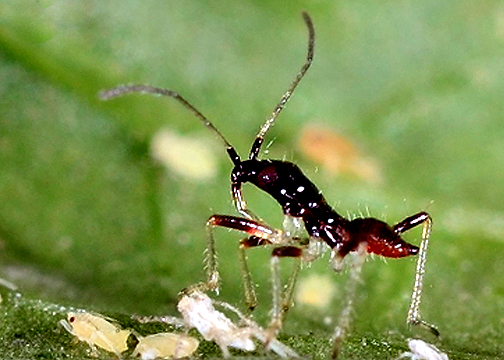Abstract
The oldest Nabinae fossil, Cretanabis kerzhneri gen. et sp. nov., is described from mid-Cretaceous Burmese amber based on a well-preserved specimen. The morphology of the nymph fossil is presented with diagnosis and description. The comparison with the nymphs of groups within Nabinae and the usefulness of nymphal morphology are discussed.
References
- Bai, M., Beutel, R.G., Klass, K.D., Zhang, W.W., Yang, X.K. & Wipfler, B. (2016) †Alienoptera—a new insect order in the roach-mantodean twilight zone. Gondwana Research, 39, 317–326. https://doi.org/10.1016/j.gr.2016.02.002
- Cornelis, M., Quirán, E.M. & Coscarón, M.C. (2012) Description of some immature stages of Nabis (Tropiconabis) capsiformis (Hemiptera: Nabidae). Revista Mexicana de Biodiversidad, 83 (4), 1009–1012.
- Cornelis, M., Diez, F. & Coscarón, M.C. (2016) Description of nymphs and additional information on Nabis ashworthi (Hemiptera: Heteroptera: Nabidae) from Patagonia, Argentina. Acta Entomologica Musei Nationalis Pragae, 56 (1), 61–70.
- Cruickshank, R.D. & Ko, K. (2003) Geology of an amber locality in the Hukawng Valley, northern Myanmar. Journal of Asian Earth Sciences, 21 (5), 441–455. https://doi.org/10.1016/S1367-9120(02)00044-5
- Damgaard, J. (2008) Evolution of the semi-aquatic bugs (Hemiptera: Heteroptera: Gerromorpha) with a re-interpretation of the fossil record. Acta Entomologica Musei Nationalis Pragae, 48 (2), 251–268.
- Elvin, M.K. & Sloderbeck, P.E. (1984) A key to nymphs of selected species of Nabidae (Hemiptera) in the Southeastern USA. Florida Entomologist, 67 (2), 269–273. https://doi.org/10.2307/3493948
- Garrouste, R., Schubnel, T., Huang, D.Y., Azar, D., Cai, C.Y. & Nel, A. (2020) Sexual conflict during Mesozoic: The first Cretaceous damsel bug in Burmese amber (Hemiptera: Heteroptera: Nabidae). Cretaceous Research, 108, 104344. https://doi.org/10.1016/j.cretres.2019.104344
- Guo, M.X., Xing, L.D., Wang, W., Zhang, W.W., Wang, S., Shi, A.M. & Bai, M. (2017) A catalogue of Burmite inclusions. Zoological Systematics, 42 (3), 249–379. https://doi.org/10.11865/zs.201715
- Henry, T.J. (2017) Biodiversity of Heteroptera. In: Foottit, R.G. & Adler, P.H. (Eds), Insect Biodiversity: Science and Society. Vol. I. Second Edition. Wiley-Blackwell, London, pp. 279–335.
- Jiang, X.R., Zhang, Z.Q., Wang, Y.M. & Kong, F.L. (2020) Gemmological and spectroscopic characteristics of different varieties of amber from the Hukawng Valley, Myanmar. The Journal of Gemmology, 37 (2), 144–162. https://doi.org/10.15506/JoG.2020.37.2.144
- Kerzhner, I.M. (1981) Fauna of the USSR. Bugs (Vol. 13, No. 2). Heteroptera of the family Nabidae. Academy of Sciences, USSR, Zoological Institute, Nauka, Leningrad, 327 pp. [in Russian]
- Kim, J., Roca-Cusachs, M. & Jung, S. (2022) Molecular phylogeny of Nabidae (Hemiptera: Heteroptera: Cimicomorpha): Insight into relationships and reclassification with the proposal of the new tribe Stenonabini. Systematic Entomology, 47 (1), 1–12. https://doi.org/10.1111/syen.12512
- Mao, Y.Y., Liang, K., Su, Y.T., Li, J.G., Rao, X., Zhang, H., Xia, F.Y., Fu, Y.Z., Cai, C.Y. & Huang, D.Y. (2018) Various amberground marine animals on Burmese amber with discussions on its age. Palaeoentomology, 1 (1), 91–103. https://doi.org/10.11646/palaeoentomology.1.1.11
- Péricart, J. (1987) Hémiptères Nabidae d’Europe occidentale et du Maghreb. Faune de France, 71, i–xi, 1–185.
- Ross, A.J. (2019) Burmese (Myanmar) amber checklist and bibliography 2018. Palaeoentomology, 2 (1), 22–84. https://doi.org/10.11646/palaeoentomology.2.1.5
- Ross, A.J. (2022) Supplement to the Burmese (Myanmar) amber checklist and bibliography, 2021. Palaeoentomology, 5 (1), 27–45. https://doi.org/10.11646/palaeoentomology.5.1.4
- Shi, G.H., Grimaldi, D.A., Harlow, G.E., Wang, J., Yang, M.C., Lei, W.Y., Li, Q. & Li, X.H. (2012) Age constraints on Burmese amber based on U-Pb dating of zircons. Cretaceous Research, 37, 155–163. https://doi.org/10.1016/j.cretres.2012.03.014
- Schuh, R.T. & Slater, J.A. (1995) True bugs of the world (Hemiptera: Heteroptera). Classification and Natural History. Cornell University Press, Ithaca, New York, 337 pp.
- Schuh, R.T. & Weirauch, C. (2020) True bugs of the World (Hemiptera: Heteroptera). Classification and Natural History (Second Edition). Siri Scientific Press, Manchester, 768 pp.


